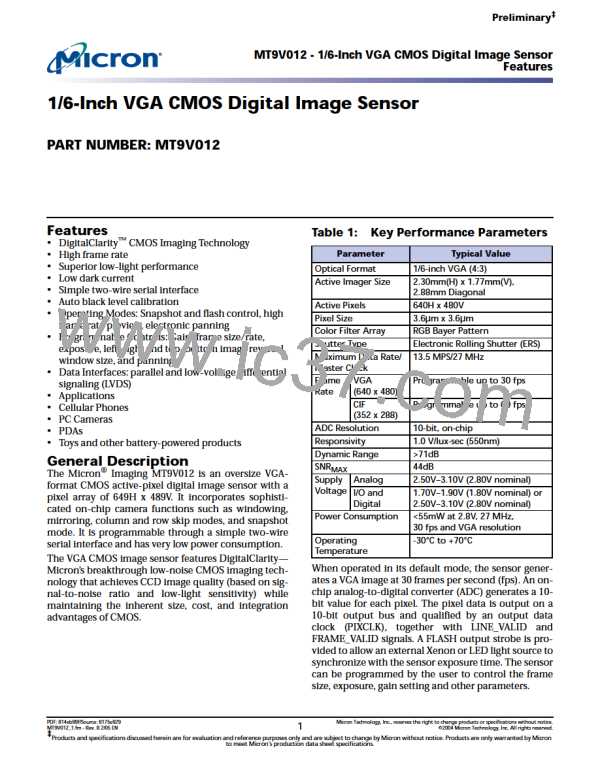‡
Pre lim in a ry
MT9V012 - 1/6-In ch VGA CMOS Dig it a l Im a g e Se n so r
Fe a t u re De scrip t io n
• The pad is normally used as an output, but is used as an input during manufacturing
test modes (e.g., DOUT(9:0)
Standard design practice dictates that signal inputs should not be allowed to float for
long periods of time. This leads to two areas where the design application should be
reviewed:
1. When using the output enable control (“Output Enable Control” on page 41), ensure
that all MT9V012 bidirectional pads that enter a high- impedance state are driven to a
valid logic level.
2. When operating the MT9V012 in serial mode ensure that unused bidirectional pads
are terminated correctly.
Some of the MT9V012 pads incorporate internal pull-up or pull-down resistors so that
they will achieve valid logic levels when left unconnected (See Table 11). These on-chip
resistors are only designed to pull an unconnected pad to a valid logic level and should
not be relied upon to provide a pull-up or pull-down to any external node.
Ta b le 11: On -ch ip Pu ll-u p s/Pu ll-d o w n s
Sig n a l
Be h a vio r
MODE1
MODE0
On-chip pull-down resistor is enabled permanently.
On-chip pull-up resistor is enabled permanently.
DOUT(9:0)
On-chip pull-down resistor is enabled when the sensor is configured to
operate in serial mode.
LINE_VALID
On-chip pull-down resistor is enabled when the sensor is configured to
operate in serial mode.
FLASH
On-chip pull-down resistor is enabled permanently.
On-chip pull-down resistor is enabled permanently.
PIXCLK
Da rk Ro w /Co lu m n Disp la y
Optically black rows from 503 through 500 and optically black columns from 694
through 692 are unused and are not normally visible in the displayed image. They can be
included in the displayed image by adjusting the window start and/ or window size reg-
isters (“Window Control” on page 32).
Optically black rows from 7 through 0 are used to provide data for black level calibration
(“Black Level Calibration” on page 40) and are not normally visible in the displayed
image. Setting Reg0x22[7] = 1 makes these rows visible in the displayed image. This is
achieved by asserting FRAME_VALID earlier than normal, and keeping it asserted
longer, so that the following rows are displayed:
• The optically black rows at the start of the pixel array (controlled by Reg0x22[2:0])
• Two rows before the visible rows
• The visible rows (controlled by Reg0x01, Reg0x03, and Reg0x20)
• Two rows after the visible rows
The effect of setting Reg0x22[7] = 1 is that the image is bigger (has more rows) than is
programmed by Reg0x03.
Optically-black columns from 23 through 0 are used to provide data for row-wise noise
cancellations (“Row-Wise Noise Cancellation” on page 41), and are not normally visible
in the displayed image. There are two methods for making them visible in the displayed
image:
1. Set Reg0x22[8] = 0 (to disable readout of the dark columns); set Reg0x30[10] = 0 (to
disable row-wise correction); then adjust Reg0x02
PDF: 814eb99f/Source: 8175e929
MT9V012_2.fm - Rev. B 2/05 EN
Micron Technology, Inc., reserves the right to change products or specifications without notice.
43
©2004 Micron Technology, Inc. All rights reserved.

 MICRON [ MICRON TECHNOLOGY ]
MICRON [ MICRON TECHNOLOGY ]